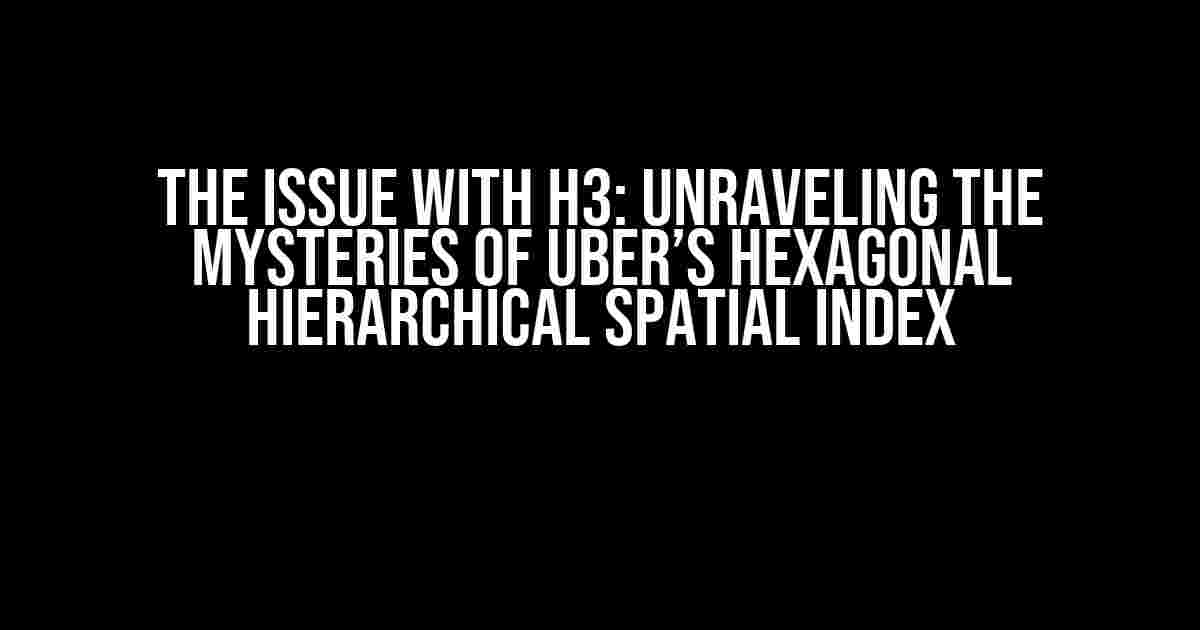Are you tired of dealing with the limitations of traditional spatial indexing methods? Do you want to unlock the secrets of efficient spatial querying and clustering? Look no further than Uber’s Hexagonal Hierarchical Spatial Index, also known as H3. In this article, we’ll delve into the world of H3 and explore the issue that has been plaguing its users – the issue with H3.
What is H3?
Before we dive into the issue, let’s take a brief look at what H3 is and how it works. H3 is a hierarchical spatial indexing system that uses a hexagonal grid to divide the Earth’s surface into smaller, manageable pieces. Each hexagon in the grid is assigned a unique index, allowing for efficient querying and clustering of geospatial data.
+---------------+ | | | Hexagon 1 | | | +---------------+ | | | Hexagon 2 | | | +---------------+ | | | Hexagon 3 | | | +---------------+
This hierarchical structure allows H3 to efficiently query and cluster geospatial data at multiple scales, from country-level aggregates to individual building footprints.
The Issue with H3
So, what’s the issue with H3? In short, it’s the trade-off between precision and performance. H3’s hierarchical structure is designed to prioritize performance, but this comes at the cost of precision. As you move up the hierarchical ladder, the precision of the indexing system decreases, leading to potential errors in querying and clustering.
This issue is particularly problematic in applications that require high precision, such as autonomous vehicles, drone navigation, or emergency services. In these cases, even a small error in spatial indexing can have significant consequences.
Causes of the Issue
So, what causes the issue with H3? There are several factors at play:
- Hexagonal Grid Approximation: H3’s hexagonal grid is an approximation of the Earth’s surface, which can lead to small errors in indexing.
- Hierarchical Structure: The hierarchical structure of H3 prioritizes performance over precision, leading to decreased precision at higher scales.
- Data Quality: Poor-quality data can exacerbate the issue, leading to further errors in indexing and querying.
Solutions to the Issue
So, how can we mitigate the issue with H3? Here are some potential solutions:
Use Case-Specific Tuning
One approach is to tune H3 to the specific use case. By adjusting the resolution and precision of the indexing system, you can optimize it for your particular application.
import h3
# Set the resolution and precision for your use case
h3.setResolution(10)
h3.setPrecision(5)
# Use H3 for querying and clustering
hexagons = h3.query('POINT(-122.084051 37.385348)')
Data Preprocessing
Another approach is to preprocess your data to improve its quality and reduce the impact of the issue. This can include:
- Data Cleaning: Remove duplicate or erroneous data points.
- Data Normalization: Normalize your data to reduce the impact of outliers.
- Data Transformation: Transform your data to improve its suitability for H3.
Hybrid Approach
A hybrid approach combines H3 with other spatial indexing systems to leverage their strengths and mitigate their weaknesses. For example, you could use H3 for coarse-grained querying and then switch to a more precise indexing system, such as a quadtree or R-tree, for fine-grained querying.
| H3 Resolution | Quadtree Resolution |
|---|---|
| 10 | 5 |
| 8 | 3 |
| 6 | 2 |
Conclusion
The issue with H3 is a complex problem that requires careful consideration and mitigation. By understanding the causes of the issue and implementing solutions tailored to your use case, you can unlock the full potential of H3 and achieve efficient and accurate spatial querying and clustering.
Remember, H3 is a powerful tool that can revolutionize the way you work with geospatial data. With the right approach, you can overcome the issue with H3 and unlock new possibilities for your applications.
Takeaway
Don’t let the issue with H3 hold you back. By following the solutions outlined in this article, you can:
- Improve the precision and accuracy of your spatial querying and clustering.
- Optimize H3 for your specific use case.
- Unlock new possibilities for your geospatial applications.
So, what are you waiting for? Dive into the world of H3 and start unlocking the secrets of efficient spatial querying and clustering today!
Here are 5 Questions and Answers about “Issue with H3: Uber’s Hexagonal Hierarchical Spatial Index” in a creative voice and tone:
Frequently Asked Question
Get answers to the most pressing questions about H3, Uber’s revolutionary hexagonal hierarchical spatial index.
What is H3, and how does it differ from traditional spatial indexing systems?
H3 is a hexagonal hierarchical spatial index developed by Uber that efficiently indexes and queries large datasets of geospatial data. Unlike traditional spatial indexing systems like quadtrees and grid-based systems, H3 uses a hierarchical, hexagonal tessellation of the Earth’s surface to index locations. This allows for more efficient and accurate spatial queries, especially at scale.
What are the benefits of using H3 over other spatial indexing systems?
H3 offers several benefits, including improved query performance, reduced storage requirements, and increased scalability. It also provides a more accurate and efficient way to perform spatial joins, aggregations, and searches, making it ideal for applications that require fast and accurate geospatial queries.
How does H3 handle issues with distortion and precision at the poles?
H3 uses a hierarchical, hexagonal tessellation that adapts to the distortion at the poles, ensuring that queries remain accurate and efficient even at high latitudes. By using a hexagonal grid, H3 minimizes the distortion and precision issues that can occur with traditional spatial indexing systems, providing more accurate results even at the poles.
Can H3 be used for applications beyond ride-hailing and transportation?
Absolutely! H3 is a versatile spatial indexing system that can be applied to a wide range of industries and use cases, including logistics, urban planning, disaster response, and more. Its ability to efficiently index and query large datasets of geospatial data makes it an ideal solution for any application that requires fast and accurate spatial analysis.
Is H3 open-source, and can I use it in my own projects?
Yes, H3 is open-source! Uber has made H3 available on GitHub, and you can use it in your own projects under the Apache 2.0 license. This means you can take advantage of H3’s powerful spatial indexing capabilities in your own applications, and even contribute to its development and improvement.


